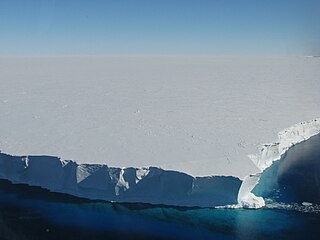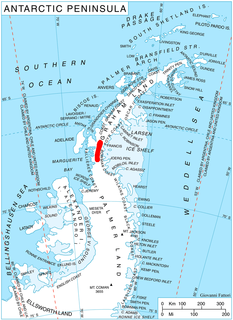
The Queen Elizabeth Range is a rugged mountain range of the Transantarctic Mountains System, located in the Ross Dependency region of Antarctica.

Lillie Glacier is a large glacier in Antarctica, about 100 nautical miles (190 km) long and 10 nautical miles (19 km) wide. It lies between the Bowers Mountains on the west and the Concord Mountains and Anare Mountains on the east, flowing to Ob' Bay on the coast and forming the Lillie Glacier Tongue.

The Usarp Mountains is a major Antarctic mountain range, lying westward of the Rennick Glacier and trending N-S for about 190 kilometres (118 mi). The feature is bounded to the north by Pryor Glacier and the Wilson Hills. Its important constituent parts include Welcome Mountain, Mount Van der Hoeven, Mount Weihaupt, Mount Stuart, Mount Lorius, Smith Bench, Mount Roberts, Pomerantz Tableland, Daniels Range, Emlen Peaks, Helliwell Hills and Morozumi Range.

Mertz Glacier is a heavily crevassed glacier in George V Coast of East Antarctica. It is the source of a glacial prominence that historically has extended northward into the Southern Ocean, the Mertz Glacial Tongue. It is named in honor of the Swiss explorer Xavier Mertz.

Utstikkar Glacier is a broad glacier flowing north from the vicinity of Moyes Peak in Antarctica and terminating in Utstikkar Glacier Tongue between Utstikkar Bay to the east and Allison Bay to the west. The glacier was mapped and named Utstikkarbreen by Norwegian cartographers working from aerial photographs taken by the Lars Christensen Expedition in January–February 1937.

Deception Glacier is a glacier between the Warren Range and the Boomerang Range, flowing south into upper Mulock Glacier. It was so named by the New Zealand party of the Commonwealth Trans-Antarctic Expedition (1956–58) because it appears to lead directly into Skelton Neve but instead drains southward.

Barcus Glacier is a glacier in the Hutton Mountains that drains east-southeast, to the north of Mount Nash and Mount Light, into Keller Inlet in Palmer Land. It was mapped by the United States Geological Survey from ground surveys and from U.S. Navy air photos, 1961–67, and named by the Advisory Committee on Antarctic Names for James R. Barcus, ionospheric physics researcher at Byrd Station in the summers of 1966–67 and 1967–68.
Bryan Glacier is a glacier that flows north along the eastern side of the Werner Mountains and merges with Douglas Glacier on entering New Bedford Inlet in Palmer Land. It was mapped by the United States Geological Survey from ground surveys and from U.S. Navy air photos, 1961–67, and named by the Advisory Committee on Antarctic Names for Terry E. Bryan, glaciologist at Byrd Station, summer 1966–67.

Chamberlin Glacier is a glacier on the east side of Hemimont Plateau which flows northeast into Whirlwind Inlet about 4 nautical miles (7 km) southeast of Matthes Glacier, on the east coast of Graham Land.
Parker Glacier is a valley glacier in the Mountaineer Range of Victoria Land which drains the area just east and northeast of Mount Monteagle, and flows south to Lady Newnes Bay where it terminates in a floating glacier tongue adjacent to Andrus Point. Mapped by United States Geological Survey (USGS) from surveys and U.S. Navy air photos, 1960-64. Named by Advisory Committee on Antarctic Names (US-ACAN) for Anthony G.H. Parker, biologist at Hallett Station in 1963-64, and McMurdo Station, 1964–65 and 1966-67.
Haines Glacier is a glacier 4 nautical miles (7 km) wide, flowing in a southeasterly direction and joining Meinardus Glacier immediately east of Mount Barkow, on the east coast of Palmer Land, Antarctica. It was discovered and photographed from the air in December 1940 by the United States Antarctic Service. During 1947 the glacier was photographed from the air by the Ronne Antarctic Research Expedition, who in conjunction with the Falkland Islands Dependencies Survey (FIDS) charted it from the ground. The glacier was named by the FIDS for William C. Haines, an American meteorologist who was a member of the Byrd Antarctic Expeditions of 1928–30 and 1933–35, and was joint author of the meteorological reports of these two expeditions.
Meiklejohn Glacier is a glacier, 12 nautical miles (22 km) long and 4 nautical miles (7 km) wide, flowing southwest from the Dyer Plateau of Palmer Land, Antarctica, to George VI Sound, immediately south of Moore Point. In its lower reaches the south side of this glacier merges with Millett Glacier. It was first surveyed in 1936 by the British Graham Land Expedition (BGLE) under John Rymill, and was named by the UK Antarctic Place-Names Committee in 1954 for Ian F. Meiklejohn, a radio operator of the BGLE.

Hauken Rock is a rock lying nearly 1 nautical mile (2 km) east of the Ornen Rocks and 2 nautical miles (4 km) northeast of Cape Melville, the eastern extremity of King George Island, in the South Shetland Islands. It was named by the UK Antarctic Place-Names Committee in 1960 from association with Ornen Rocks. Hauken and Ørnen, the first two modern whale catchers, accompanied the floating factory ship Admiralen to the South Shetland Islands in January–February 1906.
Heidemann Glacier is a glacier, 5 nautical miles (9 km) long, originating close northwest of Mount Damm in the Queen Elizabeth Range of Antarctica and flowing east into Lowery Glacier. It was mapped by the United States Geological Survey from tellurometer surveys and Navy air photos, 1960–62, and was named by the Advisory Committee on Antarctic Names for Richard P. Heidemann, a United States Antarctic Research Program glaciologist at Roosevelt Island, 1962–63.
Helen Glacier Tongue is a glacier tongue which extends seaward from Helen Glacier on the coast of Antarctica. It was discovered in November 1912 by the Western Base Party of the Australasian Antarctic Expedition under Mawson, and is named after Helen Glacier.
The Mayer Hills are low, mainly ice-covered hills with steep north-facing slopes but rather featureless summits, to about 900 metres (3,000 ft), lying south of Forster Ice Piedmont, on the Antarctic Peninsula, between Prospect Glacier and Mount Leo.They were first roughly surveyed from the ground by the British Graham Land Expedition, 1936–37. The hills were resurveyed by the Falkland Islands Dependencies Survey in 1958, and were named by the UK Antarctic Place-Names Committee after Johann Tobias Mayer (1723–1762), a German mathematician who constructed a series of lunar tables for determining longitude, published by the British Admiralty in 1775.
Hollingsworth Glacier is a broad glacier of low gradient, draining the vicinity east of the Ricker Hills and flowing northeast to enter David Glacier just east of the Trio Nunataks, in Victoria Land, Antarctica. It was mapped by the United States Geological Survey from surveys and U.S. Navy air photos, 1956–62, and was named by the Advisory Committee on Antarctic Names for Jerry L. Hollingsworth, a meteorologist with the South Pole Station winter party in 1966.

Horton Glacier is a glacier at the east side of Mount Barre and Mount Gaudry, flowing southeast from Adelaide Island into Ryder Bay, Antarctica. It was named by the UK Antarctic Place-Names Committee in 1977 for Colin P. Horton, a British Antarctic Survey builder at the nearby Rothera Station, 1976–77.
Tongue Rock is an insular rock just north of Low Tongue, off Mac. Robertson Land. Mapped by Norwegian cartographers from air photos taken by the Lars Christensen Expedition, 1936–37, and named Tangskjera. The translated form of the name recommended by Antarctic Names Committee of Australia (ANCA) has been approved.
Mount Lampert is a mountain about 6 nautical miles (11 km) west of Kelsey Cliff in the southeast part of the Guettard Range, in Palmer Land, Antarctica. It was mapped by the United States Geological Survey from surveys and U.S. Navy air photos, 1961–67, and was named by the Advisory Committee on Antarctic Names for Irwin Ronald Lampert, a storekeeper at South Pole Station in 1964.










